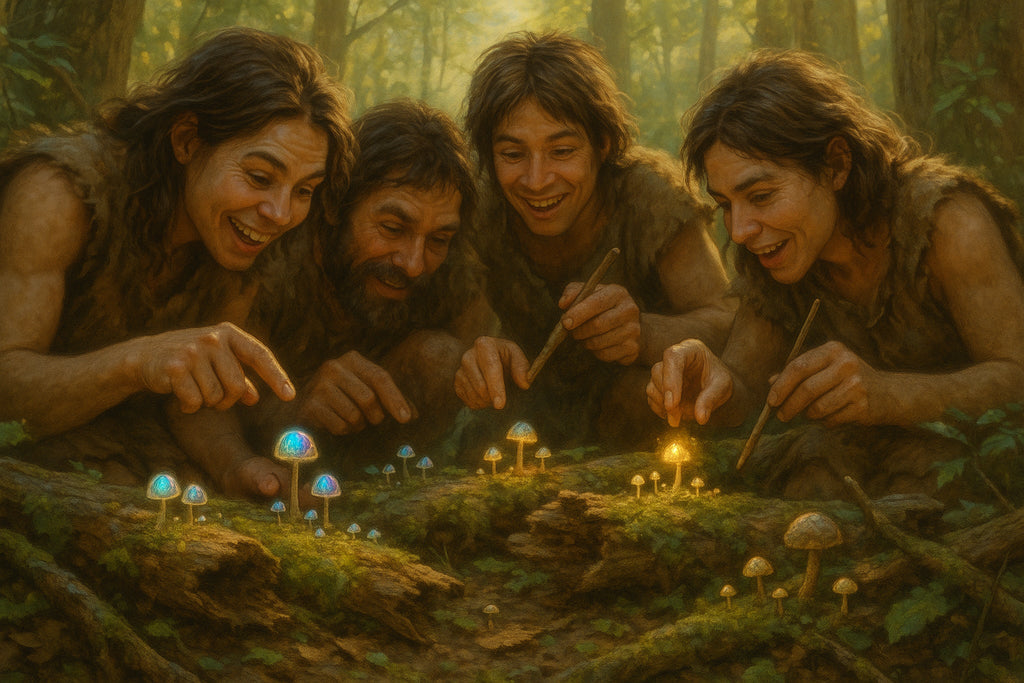The Sacred Fungus: A Deep History of Psilocybin Mushrooms and Humanity
Posted by SOUFIANE MESKINE

Psilocybin mushrooms, often called "magic mushrooms," have transcended their modern counterculture image to be recognized as one of humanity’s oldest and most profound companions. Their story is a fascinating tapestry woven through evolution, ancient ritual, scientific discovery, and a modern renaissance. This is the history of the humble mushroom that changed human consciousness.
Part 1: A Ancient Gift from Nature
Long before humans walked the Earth, psilocybin mushrooms had their own ancient origin story.
-
Evolutionary Enigma: The precise evolutionary reason fungi produce psilocybin is still debated. The leading theory, known as the "Grazing Hypothesis," suggests it is a defense mechanism. By disrupting the neurotransmitter systems of insects and other animals that might eat them, the mushrooms deter predators, ensuring their spores can be spread elsewhere.
-
A Global Fungus: Psilocybin-producing fungi are found on every continent except Antarctica. Over 180 species contain the psychoactive compounds psilocybin and psilocin, with the genus Psilocybe being the most well-known (e.g., Psilocybe cubensis and Psilocybe semilanceata). This global presence meant that many human cultures, isolated from one another, eventually discovered their properties.
Part 2: The Ancient Human Connection
Evidence suggests humanity's relationship with these mushrooms stretches back millennia, deeply rooted in spiritual and religious practice.
-
Prehistoric Rock Art: The most compelling ancient evidence comes from rock art in the Sahara Desert (Tassili n'Ajjer in modern-day Algeria). A figure known as "The Seer of Tassili," dated to 5,000-7,000 BCE, depicts a large, bee-headed figure with mushrooms sprouting from its body. Many researchers interpret this as a shamanic figure in a transformed state, using mushrooms for spiritual insight.
-
Mesoamerican Ritual and Religion: The most well-documented historical use comes from Central America. The Aztecs referred to the mushrooms as teonanácatl, which translates to "flesh of the gods." Spanish chroniclers like Bernardino de Sahagún documented their use in elaborate ceremonies, coronations, and healing rituals during the 16th century. The Mixtec, Maya, and Zapotec peoples also held them in high esteem, using them for divination, communication with spirits, and treating physical and mental ailments.
-
Other Cultural Use: While the Mesoamerican evidence is strongest, there are theories and some evidence of use in other parts of the ancient world, including:
-
India: Some scholars suggest that the mysterious ritual drink Soma, praised in the ancient Hindu text the Rigveda (c. 1500 BCE), could have been a psychedelic substance, potentially containing psilocybin or Amanita muscaria.
-
Europe: Patterns on ancient petroglyphs and burial sites have led to speculation about psychedelic mushroom use in pre-Indo-European cultures, though the evidence is less direct.
-
For these ancient cultures, the mushroom was not a drug for recreation; it was a sacred sacrament, a key to unlocking the spiritual world and accessing divine knowledge.
Part 3: Suppression and Rediscovery
The arrival of European colonizers in the Americas marked a dark period for indigenous practices, including the use of entheogens.
-
The Christian Suppression: The Spanish conquistadors and Catholic missionaries, viewing native rituals as pagan and demonic, violently suppressed the use of teonanácatl. They forced conversion to Christianity and pushed the practice underground, where it was secretly preserved by a few curanderos (healers) in remote areas for centuries.
-
The Modern Rediscovery: The modern world was largely unaware of psilocybin until 1957, when R. Gordon Wasson, a vice president of J.P. Morgan and amateur ethnomycologist, published a photo-filled article in Life magazine titled "Seeking the Magic Mushroom." Wasson described his experiences participating in a velada (healing ceremony) with the Mazatec curandera María Sabina in Oaxaca, Mexico. This article introduced psilocybin to Western society, sparking immense interest.
Part 4: The Scientific and Cultural Revolution
Wasson's account directly catalyzed the next chapter.
-
Isolation of Psilocybin: Wasson provided mushroom samples to French chemist Albert Hofmann (who had first synthesized LSD in 1938). In 1958, Hofmann successfully isolated and named the active compounds psilocybin and psilocin.
-
The Psychedelic 60s: With the compound identified and synthesized, Sandoz Laboratories began distributing pure psilocybin to researchers and clinicians. It quickly became a cornerstone of 1960s counterculture, embraced for its consciousness-expanding properties. This led to a moral panic, and psilocybin was classified as a Schedule I drug in the US in 1970, halting almost all scientific research for decades.
Part 5: The Modern Renaissance
After a 30-year freeze, the 21st century has seen a dramatic revival of interest and legitimacy.
-
The Return of Research: Pioneering institutions like Johns Hopkins University and Imperial College London secured regulatory approval to re-initiate clinical studies. Their groundbreaking work has shown remarkable potential for psilocybin-assisted therapy in treating:
-
Treatment-resistant depression
-
End-of-life anxiety in terminal cancer patients
-
Addiction (to tobacco and alcohol)
-
OCD and PTSD
-
-
Decriminalization and Legalization: A growing body of evidence, combined with shifting public opinion, has led to a reform movement. Cities like Denver, Oakland, and Washington D.C., and states like Oregon and Colorado have moved to decriminalize or create legal frameworks for therapeutic and adult use.
-
The Rise of Psychedelic Churches: In a powerful echo of its ancient past, psilocybin is once again being used in a sacred context. Modern psychedelic churches, often operating under religious freedom laws, provide a community-based, intentional framework for sacramental use, focusing on healing, spiritual growth, and connection.
Conclusion: From Ancient Rites to Modern Healing
The journey of psilocybin mushrooms is a profound circle. From their natural evolution as a protective fungus to their veneration as the "flesh of the gods," from violent suppression to clandestine preservation, and from scientific discovery to cultural exile and, finally, to a modern renaissance—their history is inextricably linked with our own.
The story of psilocybin is ultimately the story of humanity's eternal quest for meaning, healing, and a deeper connection to the universe and ourselves. As modern science begins to validate what ancient cultures held as sacred truth, this humble mushroom is reclaiming its role as one of our most powerful and mysterious teachers.
